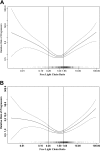Serum free light chain ratio is an independent risk factor for progression in monoclonal gammopathy of undetermined significance
- PMID: 15855274
- PMCID: PMC1895159
- DOI: 10.1182/blood-2005-03-1038
Serum free light chain ratio is an independent risk factor for progression in monoclonal gammopathy of undetermined significance
Abstract
We hypothesized that the presence of monoclonal free kappa or lambda immunoglobulin light chains in monoclonal gammopathy of undetermined significance (MGUS), as detected by the serum free light chain (FLC) assay increases the risk of progression to malignancy. Of 1384 patients with MGUS from Southeastern Minnesota seen at the Mayo Clinic from 1960 to 1994, baseline serum samples obtained within 30 days of diagnosis were available in 1148. At a median follow-up of 15 years, malignant progression had occurred in 87 (7.6%) patients. An abnormal FLC ratio (kappa-lambda ratio < 0.26 or > 1.65) was detected in 379 (33%) patients. The risk of progression in patients with an abnormal FLC ratio was significantly higher compared with patients with a normal ratio (hazard ratio, 3.5; 95% confidence interval [CI], 2.3-5.5; P < .001) and was independent of the size and type of the serum monoclonal (M) protein. Patients with an abnormal serum FLC ratio, non-immunoglobulin G (non-IgG) MGUS, and a high serum M protein level (> or = 15 g/L) had a risk of progression at 20 years of 58% (high-risk MGUS) versus 37% with any 2 of these risk factors (high-intermediate risk), 21% with one risk factor (low-intermediate risk), and 5% when none of the risk factors were present (low risk).
Figures



References
-
- Kyle RA, Therneau TM, Rajkumar SV, et al. Prevalence of monoclonal gammopathy of undetermined significance (MGUS) among Olmsted County, MN residents 50 years of age [abstract]. Blood. 2003;102: 934a. Abstract A3476. - PubMed
-
- The International Myeloma Working Group. Criteria for the classification of monoclonal gammopathies, multiple myeloma and related disorders: a report of the International Myeloma Working Group. Br J Haematol. 2003;121: 749-757. - PubMed
-
- Rajkumar SV, Dispenzieri A, Fonseca R, et al. Thalidomide for previously untreated indolent or smoldering multiple myeloma. Leukemia. 2001;15: 1274-1276. - PubMed
-
- Kyle RA, Rajkumar SV. Monoclonal gammopathies of undetermined significance. Hematol Oncol Clin North Am. 1999;13: 1181-1202. - PubMed
-
- Kyle RA, Therneau TM, Rajkumar SV, et al. A long-term study of prognosis of monoclonal gammopathy of undetermined significance. N Engl J Med. 2002;346: 564-569. - PubMed
Publication types
MeSH terms
Substances
Grants and funding
LinkOut - more resources
Full Text Sources
Other Literature Sources
Medical

